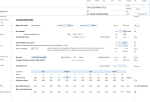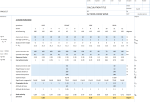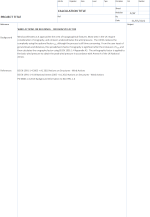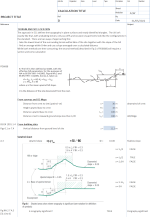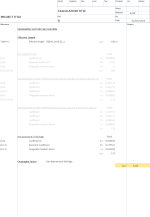Actions from Wind to BS EN 1991-1-4 and UKNA
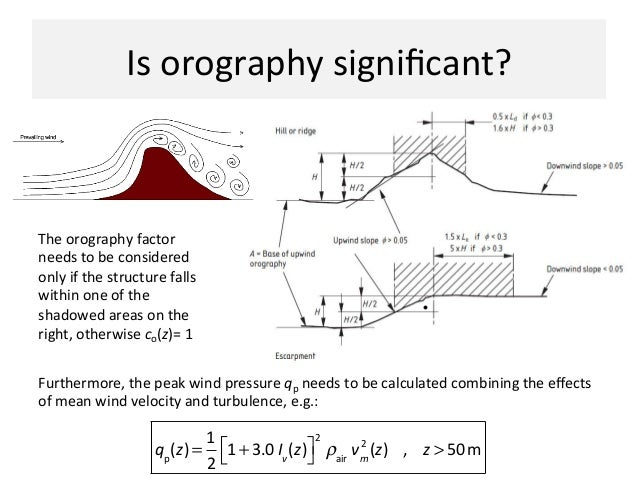
Description
Calculation of peak wind pressure to BS EN 1991-1-4 and the UK National Annex, used with either force coefficients or pressure coefficients for wind loading on structures. Using user defined location and site information, the spreadsheets takes the 'heavy lifting' out of the tables and charts for terrain category, direction factor, exposure factor, correction factor and orography factor, allowing for a rapid calculation based wind on 12 segements of 30 degrees and summarises the peak wind pressure for each quadrant. Although intended for permanent structures, options for duration (probability factor) and season are suitable for temporary works and unclad structures during erection. Applicable in the UK and Northern Ireland only. (Other locations have different approaches to basic wind speed, altitude and terrain factors).
BS EN 1991-1-4 is a part of the Eurocode that deals with the actions on structures due to wind loads. The UK National Annex provides additional guidance and country-specific parameters to be used in conjunction with the Eurocode. To calculate the peak wind pressure using BS EN 1991-1-4 and the UK National Annex, follow these steps:
-
Determine the basic wind velocity (Vb): The basic wind velocity (Vb) is the 10-minute mean wind speed at 10 meters above ground level in open country terrain with a return period of 50 years. The UK National Annex provides wind speed maps or values that can be used to determine the basic wind velocity for a specific location.
-
Calculate the mean wind velocity (Vm): To account for the height and terrain effects, multiply the basic wind velocity (Vb) by two factors, the terrain roughness factor (Kr) and the orography factor (Co). The terrain roughness factor depends on the ground roughness and the height above ground level, while the orography factor accounts for local topographic features.
Vm = Vb × Kr × Co
-
Determine the turbulence intensity (Iv): The turbulence intensity (Iv) is the ratio of the standard deviation of wind speed fluctuations to the mean wind velocity (Vm). Calculate the turbulence intensity using the equations provided in BS EN 1991-1-4 and the UK National Annex, which depend on the height above ground level and the terrain category.
-
Calculate the peak wind velocity pressure (qp): The peak wind velocity pressure (qp) is a function of the mean wind velocity (Vm) and the turbulence intensity (Iv). Calculate qp using the following equation:
qp = (1/2) × ρ × (Vm^2) × (1 + 7 × Iv)
where ρ is the air density (approximately 1.25 kg/m³).
-
Determine the pressure coefficients (Cpe, Cpi): Pressure coefficients represent the external (Cpe) and internal (Cpi) pressure distributions on the structure due to wind. These coefficients depend on the building's geometry, wind direction, and location of the surface under consideration (e.g., windward, leeward, or side walls). BS EN 1991-1-4 and the UK National Annex provide tables and figures for determining appropriate pressure coefficients.
-
Calculate the peak wind pressure (wp): Finally, calculate the peak wind pressure acting on the structure by multiplying the peak wind velocity pressure (qp) with the external and internal pressure coefficients (Cpe and Cpi).
wp = qp × (Cpe - Cpi)
The peak wind pressure (wp) can now be used in structural analyses and design calculations to ensure the structure's stability and resistance against wind loads.
In summary, calculating the peak wind pressure using BS EN 1991-1-4 and the UK National Annex involves determining the basic wind velocity, calculating the mean wind velocity, determining the turbulence intensity, calculating the peak wind velocity pressure, determining the pressure coefficients, and calculating the peak wind pressure. These steps will help you ensure that your structure is adequately designed to resist wind loads as per the Eurocode and UK National Annex requirements.
Calculation Preview
Full download access to any calculation is available to users with a paid or awarded subscription (XLC Pro).
Subscriptions are free to contributors to the site, alternatively they can be purchased.
Click here for information on subscriptions.


